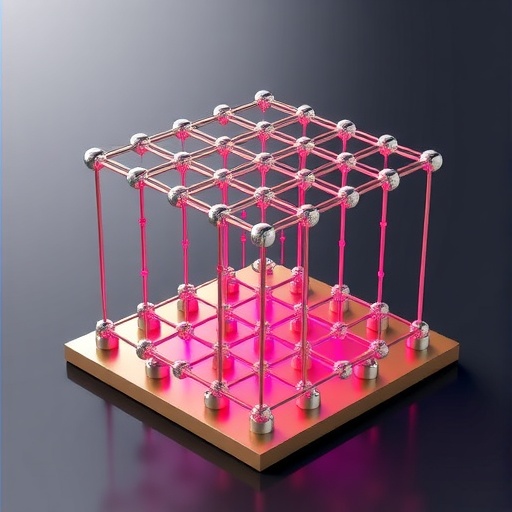The quantum anomalous Hall effect (QAHE) has been a cornerstone phenomenon in condensed matter physics, widely recognized for its potential to enable next-generation electronic devices with ultra-low energy dissipation. Traditionally confined to two-dimensional systems, the phenomenon has presented a fundamental challenge to physicists seeking its extension into three-dimensional (3D) materials. For years, this missing piece in the Hall effect family has sparked intensive theoretical speculation and experimental pursuit. Now, a breakthrough study by a collaborative research team from prestigious institutions including Fudan University and Nankai University brings this pursuit one step closer to reality by proposing a robust 3D QAHE within Weyl semimetals (WSMs).
Weyl semimetals have captivated intense research interest because of their unconventional topological properties, characterized by Weyl nodes—points in momentum space where conduction and valence bands touch—and their associated Fermi arc surface states, which defy classical surface state expectations. The team spearheaded an innovative approach by incorporating Rashba spin-orbit coupling into a time-reversal-symmetry-broken WSM model. This subtle addition induces nontrivial topological band structures culminating in a system characterized by a quantized Chern number of 1, a hallmark of quantum Hall states but now achieved in a 3D framework.
Deep theoretical modeling revealed the intricate band structures in both the bulk and surface states of the proposed system. The researchers demonstrated the emergence of unique boundary manifestations unlike those observed in conventional stacked 2D Chern insulators. Along one spatial direction, two distinct chiral surface states propagate unidirectionally, while along another axis, a pair of hinge states appear, their chirality decisively linked to the Fermi energy. Compellingly, these distinct topological states are interwoven by additional chiral surface states along the third spatial dimension, collectively embodying a novel 3D bulk-boundary correspondence principle.
One of the most striking findings is the anisotropic nature of electrical transport in this 3D QAHE phase. The Hall resistance does not assume a universal value but instead varies discretely depending on the current direction and precise Fermi energy placement. The resistance quantization takes values of 0, h/e², or ±h/e², revealing a rich landscape of transport regimes. These predictions were rigorously verified through Landauer-Büttiker formalism-based transport calculations, which also indicated remarkable resilience to typical disorder effects. Such robustness is critical for practical applications, as it signals the stability of the quantum state under realistic imperfections.
This multidimensional topology fundamentally distinguishes the system from mere layer stacking of 2D quantum anomalous Hall states, establishing a genuinely 3D quantum Hall insulator with complex interplay among surface and hinge modes. The implication of these findings is profound, suggesting that 3D topological phases can host exotic electronic phenomena inaccessible by conventional 2D systems, potentially enabling new paradigms in dissipationless transport and quantum computation.
The practical ramifications extend beyond academic curiosity. The ability to harness a stable 3D QAHE phase paves the way for a new class of low-power, topologically protected devices contributing to programmable electronics and in-memory computing architectures. These applications rely on the precise control of edge and surface states in 3D geometries, enabling robust, high-density, and energy-efficient information processing components well suited for the technological demands of the future.
To achieve experimental realization, the team points toward magnetically doped WSM compounds, which break time-reversal symmetry essential for the QAHE. Such materials are increasingly accessible due to advances in material synthesis and precision doping techniques. The experimental pursuit will likely focus on detecting quantized Hall resistance signatures and the distinctive anisotropic transport behaviors predicted, which serve as fingerprints of the 3D QAHE phase.
The understanding of 3D QAHE enriches the broader landscape of topological phases, exemplifying how spin-orbit coupling and magnetic order can intertwine to produce complex, emergent phenomena in quantum materials. This synergy enriches theoretical topological classification schemes and challenges experimentalists to explore emergent quasiparticles and boundary modes beyond conventional paradigms.
Moreover, this work underscores the critical importance of multidirectional chiral surface and hinge states in defining the electronic architecture of novel quantum phases. The ability to manipulate these states via Fermi energy tuning or directional current injection offers a tantalizing prospect for device-level control, paving the way for engineered topological circuits where information is encoded and transported with unprecedented fidelity.
In the broader context of condensed matter physics, this proposal marks a pivotal step in completing the Hall effect family, transitioning from 2D quantum anomalous Hall systems to fully fledged 3D analogs. Such progress not only satisfies longstanding theoretical quests but opens a new frontier in material functionalities endowed by topology, spin, and magnetic interactions.
While the theoretical promise is unequivocal, the path to experimental validation will require meticulous material design and measurement precision. Potential challenges include maintaining the delicate balance of magnetic doping, disorder management, and achieving the requisite Rashba spin-orbit coupling strength. Nonetheless, the roadmap provided by this study equips experimentalists with clear target parameters and transport signatures, accelerating the realization of these quantum states in laboratory settings.
Ultimately, the discovery of the three-dimensional quantum anomalous Hall effect in Weyl semimetals represents a transformative leap in the understanding and application of topological quantum materials. It exemplifies the power of theoretical innovation combined with deep physical insights, forging a path toward novel quantum devices that leverage the intricate dance of electrons in topologically nontrivial landscapes.
Subject of Research: Quantum anomalous Hall effect in three-dimensional Weyl semimetals
Article Title: Quantum Hall Effect Goes 3D: Scientists Unveil New Topological State in Weyl Semimetals
Web References: DOI: 10.1016/j.scib.2025.09.037
Image Credits: ©Science China Press
Keywords: Quantum anomalous Hall effect, 3D QAHE, Weyl semimetals, Rashba spin-orbit coupling, topological insulators, Chern number, chiral surface states, hinge states, anisotropic transport, Landauer-Büttiker calculations, magnetically doped materials, topological electronics




